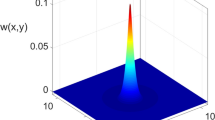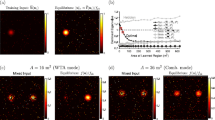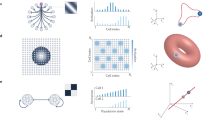Abstract
The ability of neural systems to turn transient inputs into persistent changes in activity is thought to be a fundamental requirement for higher cognitive functions. In continuous attractor networks frequently used to model working memory or decision making tasks, the persistent activity settles to a stable pattern with the stereotyped shape of a “bump” independent of integration time or input strength. Here, we investigate a new bump attractor model in which the bump width and amplitude not only reflect qualitative and quantitative characteristics of a preceding input but also the continuous integration of evidence over longer timescales. The model is formalized by two coupled dynamic field equations of Amari-type which combine recurrent interactions mediated by a Mexican-hat connectivity with local feedback mechanisms that balance excitation and inhibition. We analyze the existence, stability and bifurcation structure of single and multi-bump solutions and discuss the relevance of their input dependence to modeling cognitive functions. We then systematically compare the pattern formation process of the two-field model with the classical Amari model. The results reveal that the balanced local feedback mechanisms facilitate the encoding and maintenance of multi-item memories. The existence of stable subthreshold bumps suggests that different to the Amari model, the suppression effect of neighboring bumps in the range of lateral competition may not lead to a complete loss of information. Moreover, bumps with larger amplitude are less vulnerable to noise-induced drifts and distance-dependent interaction effects resulting in more faithful memory representations over time.





















Similar content being viewed by others
Availability of data and material
Not applicable.
References
Almeida R, Barbosa J, Compte A (2015) Neural circuit basis of visuo-spatial working memory precision: a computational and behavioral study. J Neurophysiol 114(3):1806–1818
Amari S (1977) Dynamics of pattern formation in lateral-inhibition type neural fields. Biol Cybern 27(2):77–87
Amari SI (1980) Topographic organization of nerve fields. Bull Math Biol 42(3):339–364
Avitabile D (2016) Numerical computation of coherent structures in spatially-extended systems. Second International Conference on Mathematical Neuroscience, Antibes Juan-les-Pins, 2016
Basso MA, Wurtz RH (1997) Modulation of neuronal activity by target uncertainty. Nat 389(6646):66–69
Bays PM, Taylor R (2018) A neural model of retrospective attention in visual working memory. Cogn Psychol 100:43–52
Bicho E, Mallet P, Schöner G (2000) Target representation on an autonomous vehicle with low-level sensors. Int J Robot Res 19(5):424–447
Bogacz R (2007) Optimal decision-making theories: linking neurobiology with behaviour. Trends Cogn Sci 11(3):118–125
Brody CD, Hernández A, Zainos A, Romo R (2003a) Timing and neural encoding of somatosensory parametric working memory in macaque prefrontal cortex. Cerebral Cortex 13(11):1196–1207
Brody CD, Romo R, Kepecs A (2003b) Basic mechanisms for graded persistent activity: discrete attractors, continuous attractors, and dynamic representations. Current Opin Neurobiol 13(2):204–211
Cain N, Barreiro AK, Shadlen M, Shea-Brown E (2013) Neural integrators for decision making: a favorable tradeoff between robustness and sensitivity. J Neurophysiol 109(10):2542–2559
Camperi M, Wang XJ (1998) A model of visuospatial working memory in prefrontal cortex: recurrent network and cellular bistability. J Comput Neurosci 5(4):383–405
Carandini M, Heeger DJ (2012) Normalization as a canonical neural computation. Nat Rev Neurosci 13(1):51–62
Carroll S, Josić K, Kilpatrick ZP (2014) Encoding certainty in bump attractors. J Comput Neurosci 37(1):29–48
Compte A, Brunel N, Goldman-Rakic PS, Wang XJ (2000) Synaptic mechanisms and network dynamics underlying spatial working memory in a cortical network model. Cerebral Cortex 10(9):910–923
Constantinidis C, Wang XJ (2004) A neural circuit basis for spatial working memory. Neurosci 10(6):553–565
Constantinidis C, Franowicz MN, Goldman-Rakic PS (2001) The sensory nature of mnemonic representation in the primate prefrontal cortex. Nat Neurosci 4(3):311–316
Curtis CE, Lee D (2010) Beyond working memory: the role of persistent activity in decision making. Trends Cogn Sci 14(5):216–222
Denève S, Machens CK (2016) Efficient codes and balanced networks. Nat Neurosci 19(3):375–382
Edin F, Klingberg T, Johansson P, McNab F, Tegnér J, Compte A (2009) Mechanism for top-down control of working memory capacity. Proc Nat Acad Sci 106(16):6802–6807
Erlhagen W, Bicho E (2006) The dynamic neural field approach to cognitive robotics. J Neural Eng 3:36–54
Erlhagen W, Schöner G (2002) Dynamic field theory of movement preparation. Psychol Rev 109(3):545
Erlhagen W, Bastian A, Jancke D, Riehle A, Schöner G (1999) The distribution of neuronal population activation (DPA) as a tool to study interaction and integration in cortical representations. J Neurosci Methods 94(1):53–66
Ferreira F, Erlhagen W, Bicho E (2016) Multi-bump solutions in a neural field model with external inputs. Physica D: Nonlinear Phenomena 326:32–51
Ferreira F, Wojtak W, Sousa E, Louro L, Bicho E, Erlhagen W (2020) Rapid learning of complex sequences with time constraints: A dynamic neural field model
Fotouhi M, Heidari M, Sharifitabar M (2015) Continuous neural network with windowed Hebbian learning. Biol Cybern 109(3):321–332
French DA (2004) Identification of a free energy functional in an integro-differential equation model for neuronal network activity. Appl Math Lett 17(9):1047–1051
Gazzaley A, Nobre AC (2012) Top-down modulation: bridging selective attention and working memory. Trends Cogn Sci 16(2):129–135
Haider B, McCormick DA (2009) Rapid neocortical dynamics: cellular and network mechanisms. Neuron 62(2):171–189
Hebb DO (1949) The organization of behavior: a neuropsychological theory. Chapman & Hall, J Wiley, New York
Histed MH, Pasupathy A, Miller EK (2009) Learning substrates in the primate prefrontal cortex and striatum: sustained activity related to successful actions. Neuron 63(2):244–253
Jancke D, Erlhagen W, Dinse HR, Akhavan AC, Giese M, Steinhage A, Schöner G (1999) Parametric population representation of retinal location: Neuronal interaction dynamics in cat primary visual cortex. J Neurosci 19(20):9016–9028
Johnson JS, Spencer JP, Luck SJ, Schöner G (2009) A dynamic neural field model of visual working memory and change detection. Psychol Sci 20(5):568–577
Kiani R, Shadlen MN (2009) Representation of confidence associated with a decision by neurons in the parietal cortex. Sci 324(5928):759–764
Kilpatrick ZP, Ermentrout B (2013) Wandering bumps in stochastic neural fields. SIAM J Appl Dyn Syst 12(1):61–94
Koulakov AA, Raghavachari S, Kepecs A, Lisman JE (2002) Model for a robust neural integrator. Nat Neurosci 5(8):775–782
Krishnan N, Poll DB, Kilpatrick ZP (2018) Synaptic efficacy shapes resource limitations in working memory. J Comput Neurosci 44(3):273–295
Kubota S, Aihara K (2005) Analyzing global dynamics of a neural field model. Neural Process Lett 21(2):133–141
Kuo BC, Stokes MG, Nobre AC (2012) Attention modulates maintenance of representations in visual short-term memory. J Cogn Neurosci 24(1):51–60
Laing CR, Troy WC (2003) Two-bump solutions of Amari-type models of neuronal pattern formation. Physica D: Nonlinear Phenomena 178(3–4):190–218
Lim S, Goldman MS (2013) Balanced cortical microcircuitry for maintaining information in working memory. Nat Neurosci 16(9):1306–1314
Lin PH, Luck SJ (2009) The influence of similarity on visual working memory representations. Vis Cogn 17(3):356–372
Ma WJ, Jazayeri M (2014) Neural coding of uncertainty and probability. Annual Rev Neurosci 37:205–220
Masse NY, Rosen MC, Freedman DJ (2020) Reevaluating the role of persistent neural activity in short-term memory. Trends Cogn Sci 24(3):242–258
Miller EK, Cohen JD (2001) An integrative theory of prefrontal cortex function. Annual Rev Neurosci 24(1):167–202
Mongillo G, Barak O, Tsodyks M (2008) Synaptic theory of working memory. Sci 319(5869):1543–1546
Murray JD, Anticevic A, Gancsos M, Ichinose M, Corlett PR, Krystal JH, Wang XJ (2014) Linking microcircuit dysfunction to cognitive impairment: effects of disinhibition associated with schizophrenia in a cortical working memory model. Cereb Cortex 24(4):859–872
Owen MR, Laing CR, Coombes S (2007) Bumps and rings in a two-dimensional neural field: splitting and rotational instabilities. New J Phys 9(10):378
Qi XL, Meyer T, Stanford TR, Constantinidis C (2011) Changes in prefrontal neuronal activity after learning to perform a spatial working memory task. Cereb Cortex 21(12):2722–2732
Rankin J, Avitabile D, Baladron J, Faye G, Lloyd DJ (2014) Continuation of localized coherent structures in nonlocal neural field equations. SIAM J Sci Comput 36(1):B70–B93
Rhodes BJ, Bullock D, Verwey WB, Averbeck BB, Page MP (2004) Learning and production of movement sequences: Behavioral, neurophysiological, and modeling perspectives. Hum Mov Sci 23(5):699–746
Rolls ET, Dempere-Marco L, Deco G (2013) Holding multiple items in short term memory: a neural mechanism. PLOS ONE 8(4):e61078
Rose NS, LaRocque JJ, Riggall AC, Gosseries O, Starrett MJ, Meyering EE, Postle BR (2016) Reactivation of latent working memories with transcranial magnetic stimulation. Sci 354(6316):1136–1139
Sakai Y, Okamoto H, Fukai T (2006) Computational algorithms and neuronal network models underlying decision processes. Neural Netw 19(8):1091–1105
Schneegans S, Bays PM (2017) Restoration of fMRI decodability does not imply latent working memory states. J Cogn Neurosci 29(12):1977–1994
Schöner G (2016) Dynamic thinking: A primer on dynamic field theory. Oxford University Press, Oxford
Seung HS (1998) Continuous attractors and oculomotor control. Neural Netw 11(7–8):1253–1258
Soto D, Mäntylä T, Silvanto J (2011) Working memory without consciousness. Curr Biol 21(22):R912–R913
Souza AS, Oberauer K (2016) In search of the focus of attention in working memory: 13 years of the retro-cue effect. Atten Percept Psychophys 78(7):1839–1860
Sprague TC, Ester EF, Serences JT (2016) Restoring latent visual working memory representations in human cortex. Neuron 91(3):694–707
Sutterer DW, Foster JJ, Adam KC, Vogel EK, Awh E (2019) Item-specific delay activity demonstrates concurrent storage of multiple active neural representations in working memory. PLOS Biol 17(4):e3000239
Trübutschek D, Marti S, Ojeda A, King JR, Mi Y, Tsodyks M, Dehaene S (2017) A theory of working memory without consciousness or sustained activity. Elife 6:e23871
Vokoun CR, Huang X, Jackson MB, Basso MA (2014) Response normalization in the superficial layers of the superior colliculus as a possible mechanism for saccadic averaging. J Neurosci 34(23):7976–7987
Wang XJ (2003) Persistent neural activity: experiments and theory. Cereb Cortex 13(11):1123–1123
Wang Z, Kruijne W, Theeuwes J (2012) Lateral interactions in the superior colliculus produce saccade deviation in a neural field model. Vis Res 62:66–74
Wei Z, Wang XJ, Wang DH (2012) From distributed resources to limited slots in multiple-item working memory: a spiking network model with normalization. J Neurosci 32(33):11228–11240
Wildegger T, Humphreys G, Nobre AC (2016) Retrospective attention interacts with stimulus strength to shape working memory performance. PLOS ONE 11(10):e0164174
Wilimzig C, Schneider S, Schöner G (2006) The time course of saccadic decision making: Dynamic field theory. Neural Netw 19(8):1059–1074
Wimmer K, Nykamp DQ, Constantinidis C, Compte A (2014) Bump attractor dynamics in prefrontal cortex explains behavioral precision in spatial working memory. Nat Neurosci 17(3):431–439
Wojtak W, Coombes S, Bicho E, Erlhagen W (2016) Combining spatial and parametric working memory in a dynamic neural field model. In: Artificial Neural Networks and Machine Learning — ICANN 2016, Lecture Notes in Computer Science, Springer, vol 9886, pp 411–418
Wojtak W, Ferreira F, Bicho E, Erlhagen W (2019) Neural field model for measuring and reproducing time intervals. In: Tetko IV, Kůrková V, Karpov P, Theis F (eds) Artificial Neural Networks and Machine Learning - ICANN 2019: Theoretical Neural Computation. Springer International Publishing, Cham, pp 327–338
Wojtak W, Ferreira F, Vicente P, Louro L, Bicho E, Erlhagen W (2021) A neural integrator model for planning and value-based decision making of a robotics assistant. Neural Comput Appl 33:3737–3756
Wu S, Hamaguchi K, Amari Si (2008) Dynamics and computation of continuous attractors. Neural Comput 20(4):994–1025
Zylberberg J, Strowbridge BW (2017) Mechanisms of persistent activity in cortical circuits: possible neural substrates for working memory. Annual Rev Neurosci 40:603–627
Acknowledgements
The work received financial support from FCT through the PhD fellowship PD/BD/128183/2016 the project “Neurofield” (PTDC/MAT-APL/31393/2017) and the research centre CMAT within the project UID/MAT/00013/2020.
Author information
Authors and Affiliations
Corresponding author
Ethics declarations
Conflicts of interest
The authors declare that they have no conflict of interest.
Code availability
Example codes implemented in MATLAB are available at https://github.com/w-wojtak/A-dynamic-neural-field-model-of-continuous-input-integration.
Additional information
Communicated by Benjamin Lindner.
Publisher's Note
Springer Nature remains neutral with regard to jurisdictional claims in published maps and institutional affiliations.
A Numerical simulations
A Numerical simulations
Numerical simulations of the model were done in MATLAB using a forward Euler method with parameters \(L=30\), \(N=12000\), \(\mathrm{dx}=2L/N=0.005\), \(T=100\), \(M=10000\), \(\mathrm{dt}= T/M=0.01\), unless stated otherwise in specific examples. Numerical simulations of the stochastic model were done using the Euler-Maruyama method. To compute the spatial convolution of w and f we employ a fast Fourier transform (FFT), using MATLAB’s in-built functions fft and ifft to perform the Fourier transform and the inverse Fourier transform, respectively. Periodic boundary conditions are used. By choosing a sufficiently large domain size, we make sure that the localized patterns evolve sufficiently far from the boundaries.
For performing numerical continuation, we use the method described in (Rankin et al. 2014) and adapt MATLAB code available in (Avitabile 2016). The main advantage of this method is that it can be applied directly to the full integral model. This is possible due to the usage of Newton-GMRES solvers combined with a fast Fourier transform (FFT) employed for computing the convolution term (Rankin et al. 2014).
Rights and permissions
About this article
Cite this article
Wojtak, W., Coombes, S., Avitabile, D. et al. A dynamic neural field model of continuous input integration. Biol Cybern 115, 451–471 (2021). https://doi.org/10.1007/s00422-021-00893-7
Received:
Accepted:
Published:
Issue Date:
DOI: https://doi.org/10.1007/s00422-021-00893-7




